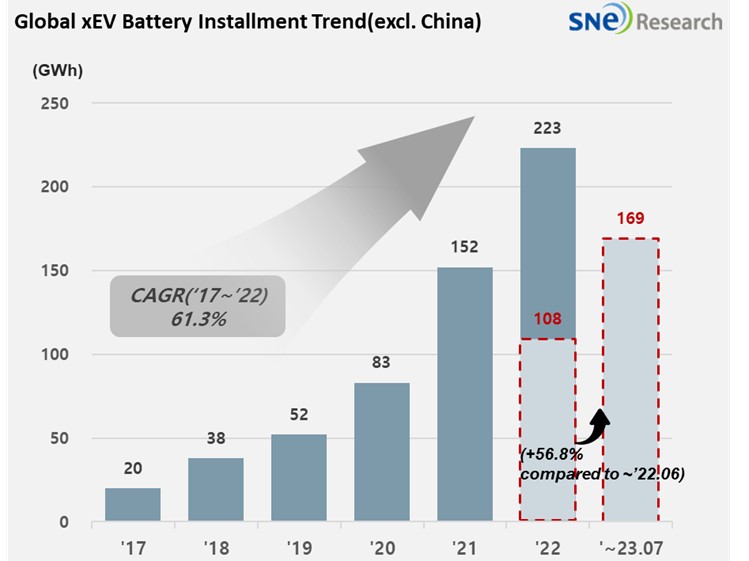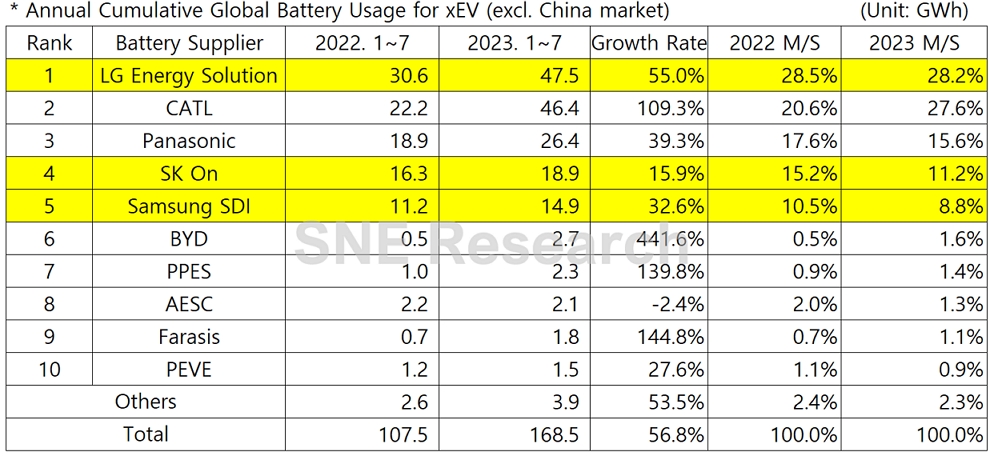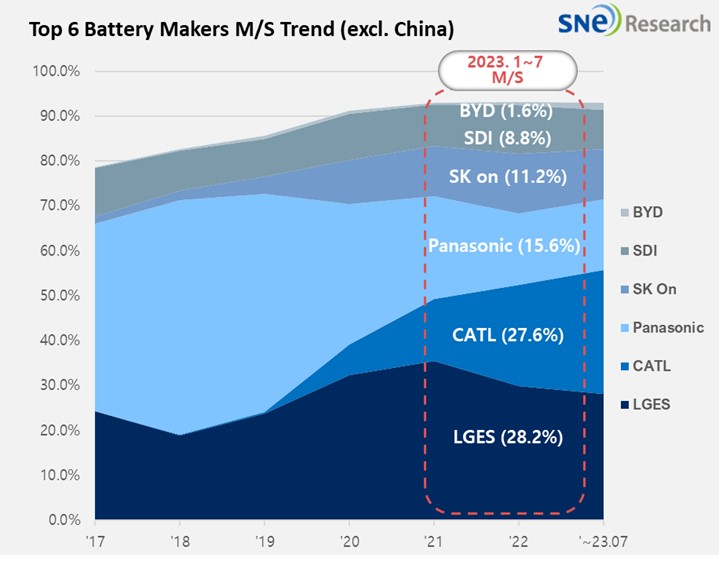From Jan to July in 2023, Non-Chinese Global[1] EV Battery Usage[2] Posted 168.5GWh, a 56.8% YoY Growth
- K-trio accounted for 48.3% M/S, with LGES keeping the top position
Battery installation for
global electric vehicles (EV, PHEV, HEV) excluding the Chinese market sold from
January to July 2023 was approximately 168.5GWh, a 56.8% YoY growth.

(Source: Global EV and Battery Monthly Tracker – August 2023, SNE Research)
In the ranking of battery usage for electric vehicles, the K-trio battery makers all entered the top 5. LG Energy Solution remained No. 1 with a 55.0%(47.5GWh) YoY growth, while SK on ranked 4th with a 15.9%(18.9GWh) YoY growth and Samsung SDI ranked 5th with a 32.6%(14.9GWh) YoY growth. CATL showed a massive growth of 109.3%(46.4GWh), following close behind LGES.

(Source:
Global EV and Battery Monthly Tracker – August 2023,
SNE Research)
The
combined shares of K-trio recorded 48.3%, a 5.9%p decline
from the same period of last year, but their battery usage was in an upward
trend. Their growth was mainly affected by favorable sales of electric vehicle
models equipped with batteries of each company. LGES kept its growth
momentum thanks to the increasing sale of Tesla Model 3/Y and Ford Mustang Mach-E.
SK on was also in an upward trajectory based on the popularity of Hyundai
IONIQ 5/6 and KIA EV6 in the global market. Samsung SDI also saw a growth driven
by Rivian R1T, BMW i4/X, and Fiat 500electric.
Panasonic registered
26.4GWh, a 39.3%
YoY growth. As one of the major battery
suppliers to Tesla, most of Panasonic’s battery usage was those installed to
Tesla in the North American market. In particular, Model Y, of which YoY growth in sales
recorded over 65%, fueled the growth momentum of Panasonic. PPES, a joint
venture between Toyota and Panasonic, recorded 2.3GWh, showing a high growth of
139.8%. The steady sales of RAV4 PHEV and the installation of Panasonic battery
to Toyota’s BEV model, bZ4X, also led the growth of the Japanese battery maker.
Along
with CATL, some of the Chinese companies have boasted an explosive,
triple-digit growth even in the non-China market, gradually expanding their
presence on the global stage. CATL ranked 2nd in
the non-China market thanks to favorable sales of Tesla Model 3/Y(made
in China and exported to Europe, North America, and Asia), KIA Niro BEV, and Volvo MG-4. As
it has been reported that CATL’s battery is installed to a new KONA model made
by Hyundai, it is forecasted that CATL’s share in the non-China market may
further expand. BYD, showing the highest growth among the top 10 companies, has
drawn a great popularity in the Chinese domestic market based on its price competitiveness
earned through vertical integration of SCM such as in-house battery supply and
vehicle manufacturing. Taking advantage of its price competitiveness, targeting
the Chinese domestic market, and product quality, BYD has been seeing a rapid increase
in its share in the markets of Europe, Asia, and Oceania.

(Source: Global EV and Battery Monthly Tracker – August 2023, SNE Research)
Driven by a strong will to enter overseas markets, the Chinese companies
have continuously posted a high growth in the non-China market. In particular, CATL has seen a sharp increase
in its market share, threatening LG Energy Solution on the top position. As global OEMs such as Tesla, Volkswagen, Ford, and Stellantis
recently announced to adopt more LFP battery, the dynamics of market seemed to tilt towards
LFP battery with
high price competitiveness. In addition, CATL enhanced the performance competitiveness
of LFP battery by unveiling the 4C superfast charging LFP battery. To be specific, attentions should be paid to
changes in the market shares of Chinese cell makers and usage of LFP battery
especially in Europe where LFP battery usage is low and entrance
barriers are lower than those of the US.
[2] Based on battery installation for xEV registered during the relevant period.

